
Oriskany's Final Days of the Great War - Australians + British tanks vs. Germans at Hamel
Australians vs. Germans at Hamel, 1918 (Part 05)
The Australians’ assault against German fortifications in front of the town of Hamel (the assault supported by British Mark V “male” and “female” tanks of the Royal Tank Corps) continues …
In previous entries, we saw where the Australian infantry made their initial advance, backed up by British tanks. The “shock barrage” of Australian artillery hit just in front of the infantry, with mixed results (in two cases almost hitting British tanks). British armor then also had mixed results with suppression fire, and finally the infantry went in with a series of bloody assaults that failed in one location but cracked the German trench in at least two others. Two turns later, the German primary trench had fallen completely, although by now almost 80 Australians are combat ineffective (killed, wounded, scattered, panicked), two of the British tanks are burning, and a third is hopelessly immobilized.
Now begins the wild firefight in the German backfield, the “second no man’s land” between their primary and secondary trench lines. German mortars continue to try to rack up “free kills” on immobilized British armor, while the mortar pits themselves are under increasing volleys of direct Australian rifle and Lewis Gun fire and even close assault.
With both sides having lost so many squads already, with the Australians having spent their “Monash Artillery Barrage” and the Germans having lost their MG 08 pits, and with no minefields or barbed wire back here to restrict movement, the fighting is now much more open, fluid, and chaotic.
In the center, bloodied Australian survivors sprint in a crouch through German communication trenches, while British tanks and German MG 08 15s and 7.58 cm “minenwerfers” hurl shells over their heads. In one case, an immobilized Mark V “male” tank is able to bring its portside 6-pounder to bear on a German MG 08 15 crew in the building to the northeast, keeping the pinned down so Ingrahm’s “valorous” platoon can continue taking apart the German north wing.
Things start to break loose for the Australians when that crippled Mark V Male manages to sail a 6-pounder HE shell right through the window of that northeast building, rolling “snake eyes” on 2d6 (best roll in the game) and positively gut the German MG team holed up in there. This means that Ingram’s platoon can enter the building for free without having to mount an actual assault. But rather than charge recklessly into the building (and thus invite opportunity or defensive fire from the Germans to the southeast), they run right up outside the building, then use the “Advance and Assault” phase to move their one free hex at the very end of the turn.
These kinds of tactics may sound “gamey,” but in fact this is where the game’s sequence is carefully designed in such a way to encourage real-life tactics. Ingram’s team doesn’t just charge in. They charge up to the building, hit their bellies, and then crawl into the building, carefully clearing and covering each corner before their mates rush up to the next fire point.
In systems like this … be gamey. It’s fine.
You’re learning tactics.
The situation at the beginning of Turn 6.
British tanks have really been hung up badly on German counterassaults and throwing tracks trying to cross trench lines. Four are burning, two are crippled … leaving just two (one “male” and one “female”) still operational on the south wing.
The German secondary trench line has fallen, and surviving German squads have now pulled back to the buildings along the western outskirts of the town. In this way, they hope to stall and bleed the Australians as much as possible, running out the clock (the game ends on Turn Eight, remember).
The Australians, for their part, are going to have to slow down their assaults. Losses have been too high, and assaults into buildings are always costly. They have to retain enough manpower to “leapfrog” squads into the outskirts of the town, and occupy enough building hexes to win the game.
Remember, the game ends at the end of Turn 8. There are sixteen building hexes in play. Both sides get one point for each building hex they control at the end of the game. So far the Australians control one. So the score is 1-15.
The Australians begin the third phase of their Hamel assault in the south, and so far things are going pretty well. That Mark V male scores enough of a hit to smash that German LMG team completely out of that building, allowing Brown’s squad to rush through the building (thus “winning” it for the Australians) and then assaulting into the next building to the east. Here things get nasty, he loses half a squad to German opportunity fire, then the other half of his squad in casualty points for the assault. Basically, Lt. Brown now stands alone, but he occupies the first hex of the second building.
On Brown’s left (north), meanwhile, Lt. Dalziel likewise makes a charge against the second hex in the building. The Mark V “female” tank to the northwest hasn’t rolled as well for covering fire, though, and again Australian losses are heavy. Half a squad is pinned down with its Lewis Gun in the open yard between the buildings, but note these counters are “straight” – no longer cocked at an angle. This is because they have rallied, making the 7 or less roll on their 2d6 (because they are Elite, usually this roll is 6 or less without an officer present).
Still, the Australians have taken three more building hexes. The score is now 4-12.
In the center and north, things haven’t really kicked off yet. With no tanks available up here, the Australians have to rely on their own rifles and Lewis Guns for suppressive fire. And so far, they’re not having much luck.
After pausing for some German fire in Turn 6 that pinned down a few approaching Australian units, as well as some shuffling of what remains of German defenses, we’re now in Turn 7.
The Australians again hit it out of the park in the south, thanks in no small part to more really great rolls from the British tanks. Seriously, these two crews must be eager for some payback for the tanks knocked across the battlefield behind them … or maybe the Australians are just jeering them mercilessly because so many of these new British Mark Vs have broken down.
In either case, the Hotchkiss machine guns of the Mark V “female” and the 6-pounder guns of the “male” are not only suppressing German units in the next couple of building hexes, they’re eliminating these German positions outright. This allows Lts. Brown and Dalziel to simply run out, Webley revolvers in hand, and lead the occupation of these buildings and bring the Australian score perilously close to actually winning this game.
Three more building hexes occupied down here, leaves the score now at 7-9. and the next German held-building hex is actually empty, thanks to the cannon fire of that Mark V “male.”
But it turns out that hex isn’t really empty. Fortune is a fickle mistress, and the Germans have snipers about …
Stay tuned !









































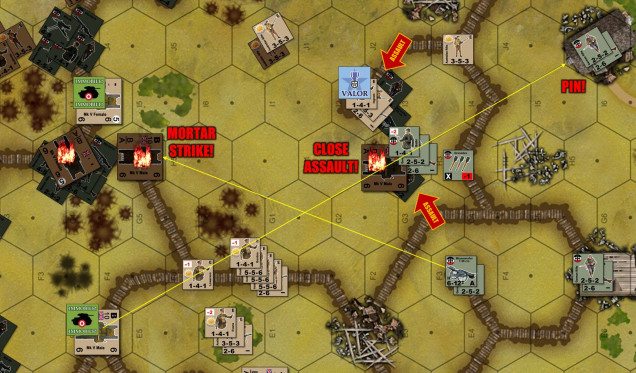
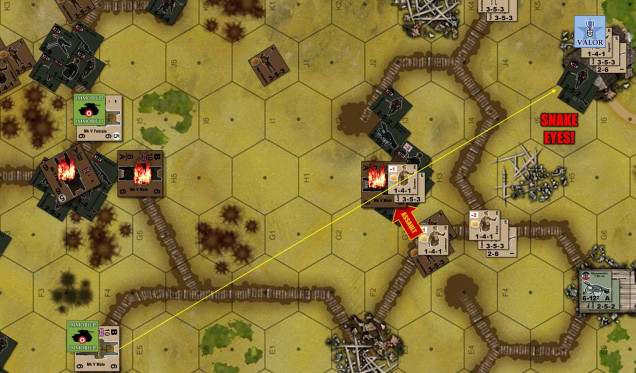
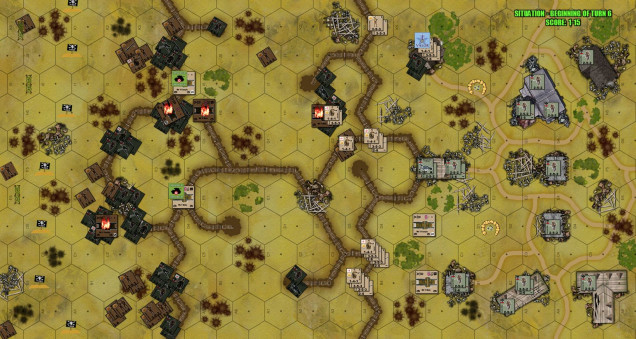
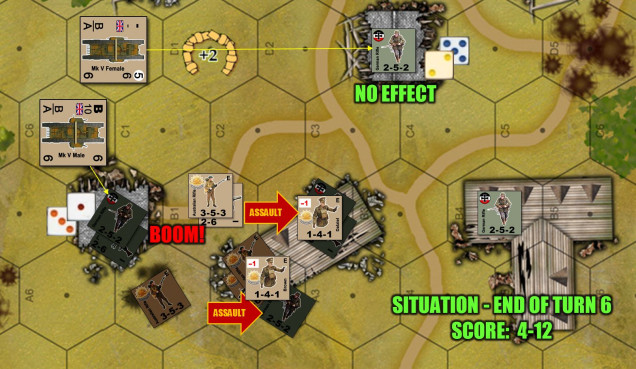
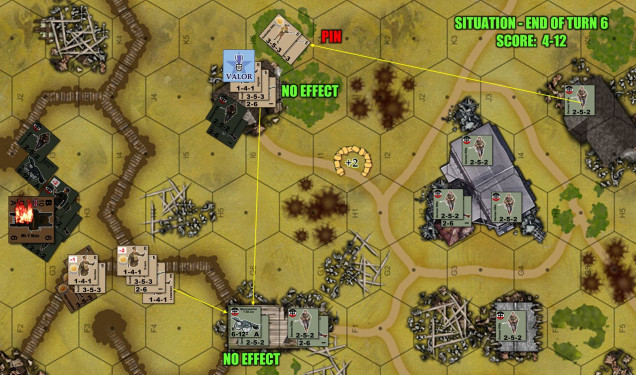
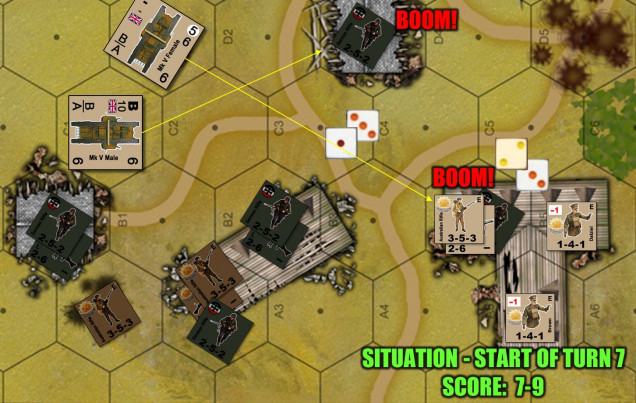

































Leave a Reply